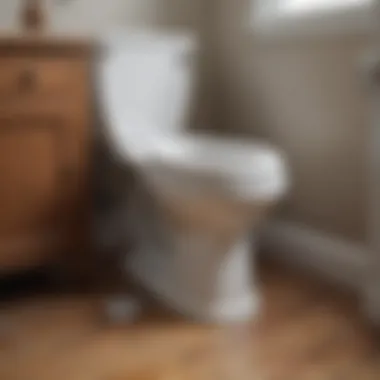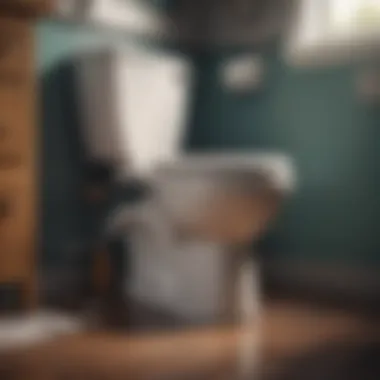Understanding Toilet De-Cloggers: A Comprehensive Guide


Intro
Toilets are central elements of modern homes, yet their performance is often taken for granted. Understanding how to keep them running smoothly is vital. Clogs represent one of the most frequent and frustrating issues homeowners face. They can cause disruptions in daily life, leading to inconvenience and costly repairs. This article presents a thorough exploration of toilet de-cloggers, addressing their necessity, mechanisms, and effectiveness.
The focus will be on the various types of de-clogging solutions available in the market. It will also delve into the science behind clogs, discussing both causes and solutions. Preventative measures are crucial for maintaining a functional toilet, and this guide emphasizes the importance of regular maintenance and proactive strategies. Troubleshooting techniques will be highlighted to empower homeowners with the knowledge to address issues independently. Additionally, alternative solutions will be considered for those looking for ways to avoid traditional de-clogging methods.
Through comprehensive discourse, readers will gain a deeper understanding of toilet care, ensuring a smoother plumbing experience, and possibly enhancing the longevity of their toilets.
The Importance of Effective Toilet Maintenance
Effective toilet maintenance is necessary for both functionality and hygiene in any home or business. Toilets are an integral part of our daily lives. They provide essential sanitation and comfort. Regular maintenance ensures that toilets operate efficiently, minimizing plumbing issues. Moreover, neglecting this aspect can lead to significant problems that affect not only the toilet itself but also the entire plumbing system.
Understanding Toilet Functionality
To maximize the efficiency of toilets, it is crucial to comprehend how they function. A standard toilet comprises several components, including the tank, bowl, and flush mechanism. When the handle is pressed, water flows from the tank into the bowl, effectively removing waste. Understanding this mechanism informs homeowners about the potential sources of clogs and the necessary steps for maintenance.
Proper use includes not flushing unsuitable items such as paper towels, feminine hygiene products, or excess waste. All these factors contribute to maintaining a clog-free experience.
The Role of De-Cloggers
In the realm of toilet maintenance, de-cloggers play a crucial role in resolving issues promptly. Whether it is a plunger, auger, or chemical solution, each tool brings unique mechanisms to address clogs effectively. Knowing when and how to use these tools can significantly reduce the hassle of clogged toilets.
The use of a plunger is often the first line of defense. It creates a vacuum that helps dislodge blockages. Alternatively, a toilet auger, or snake, is effective for more stubborn clogs located deeper in the plumbing system. Chemical de-cloggers provide a different approach by breaking down waste through chemical reactions; however, their use comes with risks such as damage to pipes and environmental hazards.
"Understanding the tools and their functions leads to an efficient and proactive approach to toilet maintenance."
Additionally, exploring natural remedies can be beneficial, as some homeowners prefer chemical-free solutions. Effective toilet maintenance involves not just knowledge of de-cloggers but also a commitment to proper waste disposal practices and regular inspections.
By prioritizing effective maintenance practices, one can avoid costly repairs and ensure smooth plumbing systems.
Types of Toilet De-Cloggers
Understanding the types of toilet de-cloggers is vital for effective maintenance and prevention of clogs. Each type comes with its unique mechanisms and suitability for different clog situations. Choosing the right de-clogger can save time, effort, and potential damage to your plumbing system. By knowing the available options, homeowners can make informed decisions tailored to their specific needs.
Plunger Basics
A plunger is perhaps the most familiar tool for tackling toilet clogs. It comes in various styles, but the standard cup plunger is the most common. Its simple design makes it easy to use. A plunger works by creating a vacuum that forces air and water through the clog. It’s essential to ensure a proper seal on the toilet bowl to maximize effectiveness.
When using a plunger, it’s important to use controlled, steady strokes. Rapid movements may not produce the desired effect. Several repetitions may be needed for stubborn clogs. Success with a plunger often depends on the material causing the blockage: liquid waste may clear easily, while solid objects could require additional effort.
Toilet Augers: An In-Depth Look
Toilet augers, often referred to as closet augers, take de-clogging a step further. They are specifically designed for toilets, featuring a long, flexible cable that can navigate bends in the drain pipe. This tool is especially useful for blockages that a plunger cannot clear.
When using a toilet auger, the user should first insert the auger head into the toilet bowl, angling it toward the drain. As you crank the handle, the auger extends and dislodges tough blockages. Care must be taken not to scratch the porcelain of the toilet. For severe clogs, a toilet auger may be necessary to fully restore flow.
Chemical Solutions and Their Risks


Chemical solutions are another widely used method for clearing clogs. Many commercial products are readily available, containing potent chemicals that dissolve waste. While effective, these solutions can pose risks. They can be harmful to pipes, especially older ones, leading to corrosion and leaks over time.
It’s also important to handle these products with care. Fumes can be toxic, and skin contact may cause irritation. In instances where chemical de-cloggers are used, the instructions provided by the manufacturer should always be followed meticulously to avoid accidents or adverse effects on plumbing.
Natural Remedies for Clogs
For those looking for safer alternatives, natural remedies present a viable option. Common ingredients like baking soda and vinegar can work effectively for minor clogs. The process involves pouring baking soda down the drain, followed by vinegar. The reaction creates bubbles that can help to break down blockages.
Another option is hot water, which can dissolve accumulated waste. Boiling water poured directly down the toilet may help relieve moderate clogs. These approaches are inexpensive and eco-friendly, appealing to homeowners conscious about their environmental impact. However, they may not be sufficient for severe blockages, where mechanical options might be necessary.
The Science of Toilet Clogging
To comprehend the most effective methods for de-clogging toilets, it is essential to delve into the science behind toilet clogs. Understanding the mechanisms that lead to blockages offers insights not only for prevention, but also for effective removal. This section will dissect various elements that contribute to clogs and elucidate the underlying dynamics of waste.
Common Causes of Clogs
In examining clogs, it’s important to recognize the range of common causes that influence toilet functionality. Each cause can lead to different strategies for prevention and resolution. Here are several key contributors:
- Excessive Waste: Toilets are designed to handle a specific volume of waste. If this limit is exceeded, clogs may occur.
- Foreign Objects: Items such as sanitary products, wipes, and children’s toys often find their way into toilets, leading to severe blockages.
- Hard Water Deposits: Over time, mineral buildup from hard water can narrow the pipes, making them more prone to clogs.
- Improper Disposal: Flushing inappropriate materials disrupts waste flow and can cause significant issues.
- Aging Pipes: Older plumbing may suffer from corrosion or reduced diameter, which increases the likelihood of clogs.
Each of these causes presents opportunities for improvement in toilet maintenance. Homeowners should consider these factors to mitigate risks and maintain effective functionality.
Understanding Waste Dynamics
The behavior of waste as it moves through plumbing systems is complex.
- Fluid Dynamics: Waste flow involves principles from fluid dynamics. The speed and direction in which waste moves impacts how easily it travels through the pipes. Any blockage affects both pressure and volume.
- Gravity's Role: Gravity assists in moving waste downward. When toilets do not achieve a sufficient flush, clogs can occur as the waste remains stagnant.
- Composition of Waste: Different types of waste behave differently. Solid waste requires more force to displace, while liquids generally flow more smoothly.
Also, understanding how waste interacts with the interior surfaces of pipes informs maintenance practices.
"Awareness of how waste dynamics influence toilet functionality can guide effective de-clogging strategies."
Variations in water pressure and toilet design also can affect the likelihood of clogs. Thus, regular assessment of waste management practices can lead to smoother operations and fewer instances of blockage.
Preventative Measures for Avoiding Clogs
Preventing toilet clogs is essential for maintaining a smooth and efficient plumbing system. Clogs can lead to frustrating situations and costly repairs, so taking proactive steps makes sense. This section highlights the benefits of regular maintenance and proper waste disposal methods to significantly reduce the occurrence of clogs.
Regular Maintenance Practices
Adopting regular maintenance practices is crucial in preserving the optimal performance of your toilet. Simple actions can greatly decrease the chance of clogs. Here are some practices to consider:
- Routine Cleaning: Regularly cleaning the toilet bowl and its submerged parts helps minimize buildup of debris and mineral deposits.
- Inspections: Periodically check the flapper and other components. Replacing worn-out parts can prevent leaks or blockages.
- Water Treatment: If you live in an area with hard water, consider using a water softener. It can reduce mineral accumulation.
By committing to maintenance, you not only keep your toilet functioning well but also extend its lifespan, thus enhancing the overall efficiency of your plumbing system.


Proper Disposal of Waste
Understanding the appropriate disposal methods is equally important for preventing clogs. Many homeowners discard items that should never be flushed, thinking they can take care of it. However, this leads to significant plumbing challenges. Here are guidelines for proper disposal:
- Flush Only Toilet Paper: The toilet is designed for human waste and toilet paper only. Items such as wipes, feminine hygiene products, and paper towels should go in the trash.
- Educate Household Members: Ensure everyone knows what can and cannot be flushed down the toilet. This education helps to avoid unexpected clogs.
- Utilize a Waste Basket: Place a basket next to the toilet for the disposal of non-flushable items, encouraging proper waste management habits.
Implementing these disposal practices can help maintain a clog-free toilet, ultimately saving time and money for homeowners.
Troubleshooting Clogged Toilets
Toilet clogs are common household issues that can cause significant inconvenience and frustration. Understanding how to troubleshoot such problems is important for any homeowner. Effective troubleshooting allows you to identify the cause and severity of the clog, which in turn dictates the appropriate response. This knowledge helps prevent escalation to more severe plumbing issues, saving both time and money.
This section will delve into two crucial aspects: First, identifying the severity of the clog allows for a focused approach to intervention. Second, mastering step-by-step de-clogging techniques equips you with the skills needed to address uncomplicated clogs successfully.
Identifying the Severity of the Clog
Recognizing the severity of a clog is the first step in resolving the issue. Not all clogs are created equal, and some may require different approaches.
- Minor Clogs: These are often the result of excessive toilet paper or small objects. The water level may remain normal, and a single flush generally resolves the issue.
- Moderate Clogs: Water may rise higher than usual, indicating a deeper blockage. Flushing may be inconsistent, producing gurgles or slow drainage. These clogs often require additional effort or tools, such as a plunger.
- Severe Clogs: Water that won’t drain or is gushing back can signal significant blockages in the plumbing system. In cases like this, professional assistance might be necessary.
"Identifying the severity of the clog can often save you time and prevent costly repairs later."
Understanding the signs of each severity level allows for quicker decision-making and tailored responses, which is both efficient and economical.
Step-by-Step De-Clogging Techniques
Once you’ve determined the severity of the clog, you can proceed with the appropriate de-clogging techniques. Here’s a practical guide:
- Use a Plunger: For minor to moderate clogs, a basic toilet plunger is usually sufficient. Ensure a good seal and use steady, forceful thrusts to create suction. This method often clears the blockage effectively.
- Try a Toilet Auger: If the plunger fails, a toilet auger can help break up more stubborn clogs. Insert the auger into the toilet bowl and twist to navigate the bends in the plumbing.
- Employ Chemical Solutions (with caution): If the clog persists, consider using a chemical de-clogger. Follow the instructions carefully since improper use can damage pipes. Always ensure that the room is well-ventilated.
- Natural Remedies: For an eco-friendly option, try pouring baking soda followed by vinegar into the toilet. Let it sit for 30 minutes, then flush. This method can help dissolve minor clogs.
- Seek Professional Help: If the clog is severe and remains after attempting these methods, it might be time to call a plumber. Services like Roto-Rooter can provide specialized equipment and expertise.
In summary, troubleshooting clogged toilets begins with assessing the severity. Armed with effective techniques, homeowners can often resolve the issue independently, contributing to a smoother and more functional plumbing system.
Alternative Solutions for Persistent Clogs
Toilet clogs can be a frustrating problem for any homeowner. When basic de-clogging methods fail, understanding alternative solutions becomes essential. This section highlights various approaches that can help in managing persistent clogs effectively. These solutions not only facilitate a practical response but can also save valuable time and resources.
When to Call a Professional Plumber
Recognizing when to call a professional plumber is crucial. Some clogs are beyond standard solutions and require expert intervention. If you notice ongoing issues, such as:
- Frequent reoccurrence of clogs
- Extensive water backups
- Slow-draining pipes irrespective of regular maintenance
it likely indicates a more serious issue within the plumbing system.
Professional plumbers can use specialized tools like video inspection cameras. This technique allows them to diagnose hidden problems in pipes, such as root intrusions or broken lines. Relying on their expertise can save you from more extensive damage that might result from attempting to resolve deep-seated issues without proper knowledge.


Cost Considerations in De-Clogging
Understanding the costs associated with various clog management solutions will aid in making informed decisions. Here are some considerations:
- DIY Methods: Using a plunger or toilet auger usually incurs minimal costs, primarily the purchase of the tool. However, if several attempts fail, the cost of time and frustration should also be taken into account.
- Chemical Solutions: Chemical de-cloggers may seem cost-effective upfront. However, the long-term implications can be significant. While they might provide quick relief, excessive use can damage pipes, leading to higher repair costs in the future.
- Professional Services: Hiring a plumber can be more expensive. Expect to pay between $100 to $400 depending on the severity of the clog and the tools required. However, this cost can be justified if it resolves persistent issues promptly, preventing further plumbing problems.
Ultimately, weighing the cost of immediate solutions against potential long-term issues is key in choosing the right approach for managing persistent clogs. By doing so, you can maintain a functional plumbing system while avoiding unnecessary expenses in the future.
The Environmental Impact of De-Cloggers
Understanding the environmental impact of toilet de-cloggers is essential for making informed choices about plumbing maintenance. With rising environmental awareness, evaluating the ecological footprint of our cleaning practices is more important than ever. De-cloggers, whether mechanical or chemical, can have both positive and negative implications on the environment. This section sheds light on the importance of selecting eco-friendly options and the long-term consequences associated with chemical treatments.
Evaluating Eco-Friendly Options
When considering which de-clogging methods to choose, it's valuable to assess their environmental effects. Eco-friendly options can often be just as effective as traditional methods, without harming ecosystems. Here are several alternatives:
- Mechanical Methods: Tools like plungers and toilet augers typically have minimal environmental impact. Since they do not rely on chemical agents, they avoid toxicity and do not lead to water pollution. These methods can efficiently clear blockages without releasing harmful residues into water systems.
- Natural Remedies: Many homeowners opt for natural solutions, such as baking soda and vinegar. These substances can break down organic matter without the use of harsh chemicals. Furthermore, they are biodegradable and safe for septic systems.
- Biodegradable Chemicals: Some products are specially designed to break down in environmentally safe ways. These alternatives often contain less harmful ingredients. It’s crucial to research the product's formulation before use.
Adopting these eco-friendly methods not only helps prevent environmental degradation but also promotes sustainable practices in everyday life.
Long-Term Consequences of Chemical Use
Chemical de-cloggers, while effective in many cases, can have long-lasting repercussions on health and the environment. Here's why it's crucial to be mindful of their usage:
- Water Contamination: Many chemical de-cloggers contain corrosive substances that can leach into water sources. This can lead to contamination of drinking water, posing potential health risks to communities.
- Impact on Flora and Fauna: Chemicals entering waterways can affect aquatic life. Harmful substances can disrupt local ecosystems, resulting in loss of biodiversity. Fish and other organisms may suffer from toxicity or altered reproductive patterns.
- Soil Health Degradation: When chemicals seep into the ground, they can harm soil quality. Healthy soil is critical for plant growth and maintaining agricultural practices. Reducing reliance on chemical products is essential to preserve these natural resources.
- Health Concerns: Prolonged use of chemical de-cloggers can expose individuals to harmful fumes and skin irritants. Some people may develop respiratory issues or skin allergies due to repeated exposure.
Consider adopting preventative maintenance practices to reduce the need for de-cloggers altogether. Regular inspections and proper waste disposal can significantly minimize plumbing issues.
Culmination
For more information on eco-friendly practices, visit Wikipedia.
Culmination: The Path to Clog-Free Toilets
In the realm of household plumbing, understanding how to maintain a clog-free toilet is essential. This article emphasizes not only the importance of effective maintenance but also the methodologies that lead to optimal plumbing systems. A clog, often dismissed as a minor inconvenience, can escalate into a significant problem, causing damage and increasing repair costs. Adequate knowledge about toilet functionality, clogging phenomena, and proactive measures can mitigate these issues.
Summary of Effective Practices
Efficient toilet maintenance encompasses various effective practices. Homeowners should prioritize the following:
- Regular Inspections: Routine checks can help identify potential issues before they escalate.
- Proper Waste Disposal: Ensuring that only suitable items enter the toilet is crucial. This means avoiding flushing items such as wipes or sanitary products.
- Use of De-Cloggers: Knowing when to use different de-clogging methods—such as plungers or augers—can save time and resources.
- Natural Remedies: Simple solutions like vinegar and baking soda can assist in preventing minor clogs.
By adhering to effective practices, homeowners can achieve a reliable plumbing system. The utilization of the right de-clogging tools, combined with preventive strategies, forms a comprehensive approach to maintenance.
Future Innovations in Toilet Maintenance
As technology continues to evolve, the future of toilet maintenance looks promising. Innovations are emerging in various areas, as highlighted below:
- Smart Toilets: These incorporate sensors that provide real-time feedback on clogs and maintenance needs. They help in monitoring usage patterns and can alert homeowners to emerging problems.
- Eco-Friendly Products: The demand for sustainable solutions is increasing. Companies are now creating environmentally friendly de-clogging options that are both effective and safe.
- Automated Maintenance Systems: These systems automate flushing and cleaning cycles, which can reduce the buildup of waste materials that lead to future clogs.
By keeping an eye on these innovations, homeowners can adopt systems that not only alleviate existing issues but also enhance long-term efficiency. Staying informed about new developments can significantly improve toilet maintenance outcomes.







